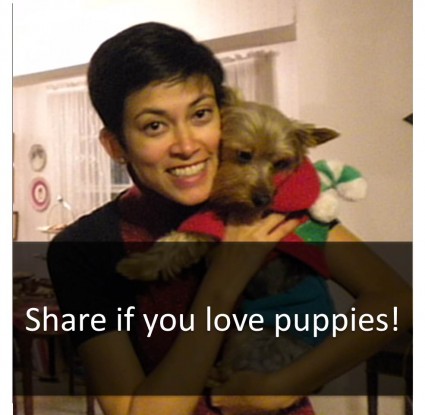You can easily find blanket pronouncements about social media: Facebook posts with pictures get 67% more likes, LinkedIn sends twice as much traffic as Instagram, questions get the most engagement on Twitter… These claims are meaningless unless they’re followed by a statement like, “… in 2013, for surveyed established B2B logistics companies working with SMBs where the primary decision makers are male.”
There’s no such thing as one-size-fits-all social media.
We saw an interesting confirmation of this recently with a client who had us create three boosted posts one week. These posts all had the same budget and other ad settings, they all linked back to strong blog posts on the client’s website, and they were all boosted at about the same time of day on weekdays.
One was a shameless emotional appeal in the form of a question with an attractive conceptually-related photo — the classic Facebook boosted post, in other words. Another was a news story involving a celebrity important to the audience, with a photo of the celebrity. The third was an ordinary news post with the client’s logo on the link, and no photo.
How do you think these three posts did?
Which type of post had the best results?
Here were the results, using a variety of metrics:
| Post Likes | Comments | Engagement | Shares | Web Visits | Reach | |
| Question | 143 | 28 | 3.38% | 43 | 136 | 18,300 |
| Celebrity | 49 | 27 | 2.23% | 21 | 184 | 19,900 |
| News | 45 | 1 | 1.16% | 11 | 175 | 21,600 |
That’s a lot of numbers, so here’s a graph to help sort it out:
Seeing a clear winner yet? Each of the posts was a winner for at least one of these metrics.
If we look at Comments and Likes, which is as far as many people look, we find that the Question post was a clear winner, with the Celebrity as a clear runner-up:
But when it comes to getting visitors back to the website where they can make purchases or sign up — the primary goal of most business social media campaigns — we see quite a different picture, with the Celebrity beating out the others, and the Question post in last place:
When we look at Reach, the primary goal for this particular client, we see the opposite order from what we saw for Likes, though not as big a difference among the three:
When we combine all the metrics in our calculations, we get back to the first order we saw — but the results are quite close.
What does this tell us about Facebook posts?
First, if you’re just out for Likes, you may find the common wisdom useful: ask questions, use pretty pictures, and appeal to your visitors on a more playful and emotional level. Getting Likes on posts can increase the number of times Facebook shows your posts organically and make people think you’re popular and therefore someone they should also Like. If you’re trying to sell ads or to become a major trend, Likes can really be currency, because your popularity is what you’re selling. It can also help you convince your boss that you’re right to make an investment in Facebook, and sometimes that’s a tough sell.
Second, don’t forget your actual goals. Lots of Facebook Likes is a vanity metric, something you can buy directly, and usually not aligned with business goals in any way. If that’s all you’re going for (with the exceptions listed above), your ROI is probably not what it could be. Don’t be distracted by Likes from the meatier metrics like web traffic and conversions. For this client, we will probably recommend boosting hot news stories most of the time, and we’ll use cheap Facebook tricks only occasionally. Since all three of the posts linked to strong blog posts, we’re probably seeing Likes and Comments and Shares on the Question post from people who Liked and answered the question itself, without bothering to click through and read the whole story. That may be the equivalent of those “Share if you love puppies!” posts — they may get engagement, but they don’t sell the dog food.
Finally, check your own data. Our favorite economist assured me that we’d need to collect way more data and run a regression before we could conclude anything from this information. That may be true, but we can see enough of a trend here to inform our future decisions about which posts to boost and how to present them. We can continue to watch our results and fine tune our boosted posts to get the results we want.
Those results — and the data — are likely to be quite different for your company. We would expect them to be different for each of our clients. That’s why we start out with best practices and common wisdom… but never stop there.







Leave a Reply